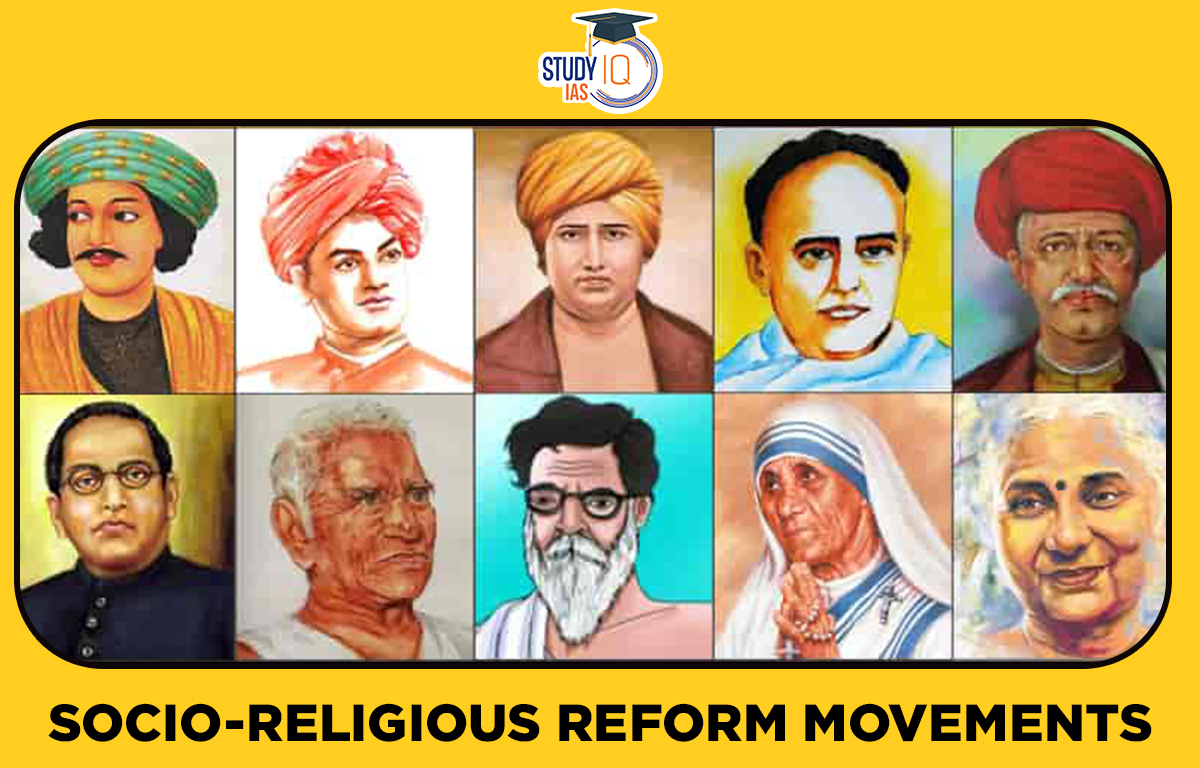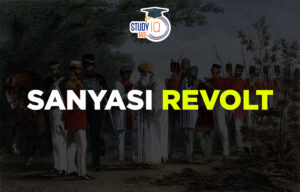Table of Contents
India’s socio-religious reform movements were key responses to British colonialism, modernity, and the internal decay of socio-religious institutions. These movements aimed at social and religious upliftment, rectifying regressive traditions while embracing certain modern ideas.
Socio-Religious Reform Movement
All Indian communities saw social and religious reform movements. They battled prejudice, superstition, and the influence of the clerical elite. They advocated against sati, child marriage, the purdah system, castes, untouchability, socioeconomic inequality, and illiteracy.
Some of these reformers received sponsorship from British authorities, either directly or indirectly, and some of the reformers also backed reform-oriented policies and laws developed by the British Government. You will learn about the Socio-Religious Reform Movements (SRRM) in this article, which will help you prepare for the UPSC Civil Service Exam.
Read More: Sargeant Plan of Education
Socio Religious Reform Movements History
Indian society was rigid, caste-based, and debauched in the early nineteenth century. It endorsed some actions that went against moral principles or humane sentiments but were nonetheless done in the name of religion. In order for Indian society to meet the challenges of the West, certain enlightened Indians, such Raja Ram Mohan Roy, Ishwar Chand Vidyasagar, Dayanand Saraswati, and others, started to undertake reforms.
The two main categories of reform movements are reformist movements and revivalist movements. Brahmo Samaj, Prarthana Samaj, and the Aligarh Movement are a few examples of reformist movements.
Examples of revivalist movements include the Arya Samaj and the Deoband movement. Both the reformist and revivalist movements, to varying degrees, depended on an appeal to the religion’s lost purity in order to advance their goals. The only thing that separated reform movements was how much they depended on tradition as opposed to reason and conscience.
Read More: Wardha Scheme
Socio-Religious Reform Movements Reason for Rise
The socio-religious reform movements in 19th and early 20th century India arose due to a combination of internal and external factors. These movements aimed to address the challenges posed by colonial rule, modernity, and the decline of socio-religious institutions. Below are the key reasons for their emergence:
- Impact of British Rule: Western education, liberal ideas, and Christian missionary criticism led to introspection and reform among Indians. Exposure to rational thinking prompted the questioning of traditional practices.
- Degeneration of Religious Practices: Corruption, superstition, and ritualistic excesses plagued religious practices. Social evils like caste discrimination, Sati, child marriage, and the oppression of women triggered calls for reform.
- Response to Modernity: The need to reconcile traditional beliefs with modern science and rationalism drove reformers to reinterpret religious texts and practices to align with contemporary ideas.
- Nationalism and Identity Formation: Reform movements were intertwined with the rise of Indian nationalism, aiming to revive religious purity and foster a collective cultural identity to resist colonialism.
Read More: Sadler Commission
Socio-Religious Reform Movements in Hindu Importance
| Movement | Founder/Leader | Principles | Impact |
|---|---|---|---|
| Brahmo Samaj | Raja Ram Mohan Roy | Advocated monotheism, opposed rituals, priesthood, and caste discrimination. | Promoted rationalism, helped social reforms, influenced Indian nationalism. |
| Atmiya Sabha | Raja Ram Mohan Roy | Promoted Vedanta monotheism, fought idolatry, caste, and rituals. | Early reformist organization, inspired modern Hindu reform movements. |
| Tattvabodhini Sabha | Debendranath Tagore | Focused on studying Indian history, promoting the ideals of Brahmo Samaj. | Revitalized Brahmo Samaj, contributed to intellectual Hindu revival. |
| Prarthana Samaj | Atmaram Pandurang, K.C. Sen | Focused on social reform, caste abolition, and liberal values. | Encouraged reform through education, influenced Maharashtra’s reform movement. |
| Young Bengal Movement | Henry Louis Vivian Derozio | Promoted radical ideas, inspired by British liberalism and the French Revolution. | Advocated for women’s rights, social justice, and education reform. |
| Arya Samaj | Swami Dayanand Saraswati | Advocated a return to Vedic ideals, rejected Puranas, opposed idolatry, caste. | Established educational institutions, led to Hindu revival in North India. |
| Ramakrishna Mission | Swami Vivekananda | Combined modern ideas with Hindu philosophy, opposed caste and ritualism. | Promoted social service, national pride, and spiritual awakening in India. |
1. Brahmo Samaj
Its main objective was to adore the almighty God. It was hostile to sacrifices, rites, and the priesthood. It was primarily focused on reading the Bible, praying, and reflecting. It firmly believed that all religions are interconnected. It was the country’s first intellectual reform movement in modern times.
It led to an increase in India’s rationalism and enlightenment, which indirectly benefited the nationalist struggle. It served as the model for all social, religious, and political movements in modern India. The Brahmo Samaj of India, led by Keshub Chandra Sen, and the Adi Brahmo Samaj, led by Debendranath Tagore, split apart from it in 1866.
2. Atmiya Sabha
The mission of the Atmiya Sabha was to advance Vedanta’s monotheistic beliefs and combat idolatry, rigid caste systems, pointless rituals, and other societal ills. Raja Ram Mohan Roy, who was much influenced by rationalist ideas, asserted that Vedanta is based on reason and that, if reason demanded it, even deviating from the scriptures is permitted.
3. Tattvabodhini Sabha
Debendranath Tagore, the father of Rabindranath Tagore, established the Tattvabodhini Sabha in 1839. He injected new life into the Brahmo Samaj when he joined in 1842. He dedicated to conducting an objective and thorough study of India’s history. He shared Roy’s opinions.
4. Prarthana Samaj
In 1867, Keshab Chandra Sen helped Atmaram Pandurang create the Prarthana Samaj in Bombay. A precursor to the Prarthana Samaj was the Paramahansa Sabha, a form of covert organisation that supported liberal principles and encouraged the eradication of caste and communal barriers. The Samaj’s approach focused more on education and persuasion than it did on opposing traditional Hinduism. Dhondo Keshav Karve and Vishnu Shastri were social reformers in addition to Ranade.
5. Young Bengal Movement
Intellectuals from the Hindu College of Calcutta were at the fore of the new Bengal movement. The term “Derozians” was also used to describe these philosophers. Through his teaching and the establishment of a discussion and debate group on literature, philosophy, history, and science, Derozio promoted radical viewpoints. They held a high regard for British liberalism and the concepts of the French Revolution (1789 A.D.). The Derozians also supported education and women’s rights.
6. Arya Samaj
The Arya Samaj’s primary objective was modernizing Hinduism in northern and western India. Swami Dayanand believed that the Puranas, which he said contained false beliefs, had helped selfish, ignorant priests corrupt Hinduism. The Vedas, which Swami Dayanand revered as the inerrant source of all knowledge and the sacred word of God, served as a source of inspiration for him. Later, some of Swami Dayanand’s followers set up a network of colleges and universities across the nation to offer a Western-style education. Lala Hansraj was one of the people that inspired this project.
7. Ramakrishna Mission
Vivekananda spread Ramakrishna’s religious teachings to a wide audience. He made an effort to modify it to meet the needs of contemporary Indian society. He was also persuaded of the superiority of the Indian philosophical tradition’s methodology at the same time. Indians were criticized by Vivekananda for becoming immobile and mummified after cutting off ties with the outside world. Hinduism’s reliance on rituals and superstitions, as well as the caste system, were issues that Vivekananda openly opposed.
Read More: Raleigh Commission
Socio-Religious Reform Movements in Muslim Importance
| Movement | Founder/Leader | Principles | Impact |
|---|---|---|---|
| Wahabi Movement | Syed Ahmed | Advocated for a return to pure Islam of the Prophet’s time, rejected Western influences. | Anti-British sentiment; was weakened by British military action in the 1860s. |
| Ahmadiyya Movement | Mirza Ghulam Ahmad | Promoted universal religion, renounced jihad, and focused on peace and justice. | Aimed at Mohammedan Renaissance; Western liberal education for Muslims. |
| Aligarh Movement | Syed Ahmad Khan | Promoted modern education, social reform, and unity between Muslims and Hindus. | This led to the establishment of Aligarh Muslim University. |
| Deoband Movement | Islamic Scholars | Focused on Islamic law (Shariat), Sufism, and religious knowledge. | Rejected ritualistic practices, and emphasized scholarly interpretation of Islam. |
| Barelvi Movement | Syed Ahmad Rai Barelvi | Advocated puritanical extremism, jihad, and Sufism’s spiritual discipline. | Influenced radical jihadist groups, called for militant jihad. |
1. Wahabi Movement
Syed Ahmed advocated for the revival of authentic Islam and Arabian culture as it was during the time of the Prophet and rejected Western influences on Islam. The perfect leader was lauded as Syed Ahmed (Imam). A large organization with a complex secret code was created to function under spiritual vice-regents (Khalifas).
Anti-British sentiment was instilled in large part by the Wahabis. The Wahabi resistance was weakened by a series of British military attacks on the Wahabi base at Sithana in the 1860s as well as numerous court cases alleging sedition against the Wahabis. Interactions with the government persisted intermittently until the 1880s and 1890s.
2. Ahmadiyya Movement
A Muslim sect called the Ahmadiyya first appeared in India. It described itself as representing the Mohammedan Renaissance. It was established on the same principles of a universal religion for all humans, renouncing jihad, as the Brahmo Samaj (holy war against non-Muslims). The initiative offered Western liberal education to Indian Muslims. The only Islamic community that holds the view that Mirza Ghulam Ahmad is the Messiah who came to put an end to religious conflict and slaughter and to establish morality, peace, and justice is the Ahmadiyya community.
3. Aligarh Movement
Syed Ahmad Khan was a staunch supporter of what is frequently referred to as “practical morality,” the fundamental unity that underlies all religions. He also discussed the intrinsic parallels between Muslim and Hindu goals. He established the Scientific Society in 1862 to translate works on science and other topics into Urdu. Additionally, he established an English-Urdu monthly through which he disseminated concepts for social change. His work resulted in the establishment of the Mohammedan Oriental College, which later developed into the Aligarh Muslim University.
4. Deoband Movement
Deobandis believed that Islam had two main tenets: tariqah and shariat (law based on books and religious knowledge) (religious knowledge). They adopted Sufism and its various forms of discipline as a result, as well as the role played by ulama in interpreting the four schools of Islamic law. The Deobandis followed Sufism but rejected several rituals and the authority of pirs who claimed sanctity by ancestry rather than education.
5. Barelvi Movement
The most prominent Wahhabi advocate in India, Syed Ahmad Rai Barelvi was a strong supporter of puritanical extremism and violent jihad. He was first influenced by Sufi groups and silsilas such Naqsyabandiyah, Chishtiya, and Qadriyah. Although Syed Ahmad’s Mujahidin movement is no longer active among Indian Muslims, millions of people are nevertheless impacted by his calls for jihad as “an act of devotion greater than spiritual prayer in merit and rewards.” As a result, some radical jihadist groups have declared the Mujahidin movement of Rai Barelvi to be resurrected in the subcontinent.
Read More: Hunter Commission
Socio-Religious Reform Movements in Sikh Importance
| Movement | Founder/Leader | Principles | Impact |
|---|---|---|---|
| Akali Movement | Evolved from Singh Sabha Movement | Focused on liberating Sikh gurdwaras from corrupt Udasi mahants. | Led to Gurdwara Reform, establishment of Sikh control over gurdwaras. |
| Nirankari Movement | Baba Dayal Singh (Nirankari) | Emphasized proper religious behavior, rejected hereditary priesthood. | Helped distinguish Sikhs from Hindus, grew under British presence in Punjab. |
1. Akali Movement
The Singh Sabha Movement gave rise to the Akali Movement, commonly referred as as the Gurdwara Reform Movement. Its objective was to release tyrannical Udasi mahants from control of the Sikh gurudwaras (the position had become hereditary).
2. Nirankari Movement
The Nirankaris placed a strong emphasis on proper religious behaviour, creating hukamnamas to outline what was acceptable and developing a network of temples staffed by their own priests. They didn’t fight or struggle with the British; instead, they expanded as a result of their presence in Punjab, which freed them from the Sikh government’s restrictions. As a result, the Nirankaris were accepted as a permanent subset of the Sikh faith and helped to define the boundaries between Sikhs and Hindus.
Read More: Macaulay Minute
Socio-Religious Reform Movements Positive Aspect
The orthodox segments of society were unable to accept the scientific ideological assault of the socio-religious rebels. So, the reactionaries insulted, persecuted, issued fatwas against the reformers, and even attempted to kill them. Despite the opposition, these organizations were able to help people become free from fear-based submission and uncritical submission to exploitation by priests and other classes.
With the translation of religious texts into everyday languages, the emphasis on each person’s right to interpret the scriptures, and the simplicity of ceremonies, worship became a more intimate experience. The movements placed a strong emphasis on the capacity for thought and reasoning in humans. By eliminating corrupt elements, religious beliefs, and habits, the reformers enabled their supporters to respond to official criticism that their faiths and culture were decadent and inferior.
The reform movements gave the emerging middle classes the cultural roots they so desperately needed and a way to lessen the humiliation they felt as a result of being annexed by a foreign country. Recognizing the peculiar demands of modern times, notably in terms of scientific knowledge, and supporting a contemporary, this-worldly, secular, and rational mindset were essential contributions of these reform initiatives.
Socially, this mindset was reflected in a major change in the ideas of “purity and pollution.” Although the primary targets of the reformers’ criticisms were old beliefs and customs, the reformers actually desired modernization rather than complete westernization based on mindless replication of foreign Western cultural norms. Indeed, reform movements sought to create a social environment that was conducive to modernization.
Read More: Hartog Committee
Socio-Religious Reform Movements Negative Aspect
One of the main drawbacks of religious reform movements was that the vast majority of peasants and urban poor were ignored in favor of a narrow social base, particularly the educated and middle classes. The reformers’ penchant for extolling the virtues of the past and relying on scriptural authority encouraged mysticism in new forms and promoted pseudo-scientific thinking while hindering full acceptance of the need for a modern scientific approach.
The compartmentalization of Hindus, Muslims, Sikhs, and Parsis, as well as the separation of high-caste Hindus from low-caste Hindus, was primarily a result of these tendencies. The development of communal consciousness alongside national consciousness among the middle classes looked to be impeding the emergence of a composite culture, which had been evident throughout Indian history.
The character of religious reform organizations also played a part in the revival of communalism in modern times, but there were probably many other factors at play. Regardless of the overall result of these reform initiatives, it was through this conflict that a new society in India arose.
Read More: Wood’s Despatch
Socio-Religious Reform Movements Impact
The British intended to satisfy the top crust of society. As a result, just two significant pieces of legislation were enacted. Some legal measures were enacted to improve women’s standing. Sati, for example, was banned (1829). Infanticide has been made illegal. Legislation approved in 1856 allowed widow remarriage. A law passed in 1860 elevated the marriageable age of females to 10. Inter-caste and inter-communal marriages were legalized in 1872 by legislation.
The other law, which was passed in 1891, was designed to prevent underage marriage. In 1929, the Sharda Act was passed in an effort to prevent child marriage. According to the law, a boy under the age of 18 and a girl under the age of 14 cannot wed. Particularly after 1919, the Indian national movement emerged as the main proponent of social reform.
The reformers increasingly depended on propaganda in Indian languages to reach the general public. To spread their message, they also used the press, novels, plays, short stories, poetry, and, in the 1930s, a movie.
In order to increase women’s access to education, prevent young children from getting married, remove women from purdah, uphold monogamy, and allow middle-class women to pursue careers in the private sector or the public sector, a number of people, reform societies, and religious institutions worked hard.
All of these initiatives led to Indian women taking an active and crucial role in the nation’s battle for independence. As a result, many superstitions were eliminated and many more were in the process of being eliminated. Traveling abroad was no longer considered sinful.
Socio-Religious Reform Movements UPSC
More people began to value Indian culture in the 1800s and 1900s, but they also became outspoken opponents of its drawbacks. In order to alter Indian society, several leaders emerged. They mainly aimed to ingrain modern values into Indian society.
Liberty, social and economic equality, fraternity, democracy, and justice were among the ideas that had a big impact on Indian society. Raja Ram Mohan Roy, Dayanand Saraswati, and many more progressive Indians were willing to put up a fight and bring about social changes so that our nation could face the challenges of the West, which was fortunate for our country. For UPSC exam preparation, read up on all the Socio-Religious Reform Movements.


 Maharashtra’s Mendrachi Vancharai Syst...
Maharashtra’s Mendrachi Vancharai Syst...
 Keeladi Excavation: Uncovering the Ancie...
Keeladi Excavation: Uncovering the Ancie...
 Sanyasi Revolt, Objectives, History, Rea...
Sanyasi Revolt, Objectives, History, Rea...





















